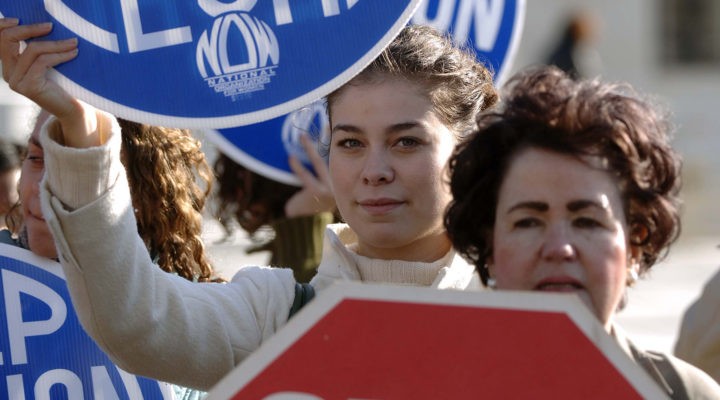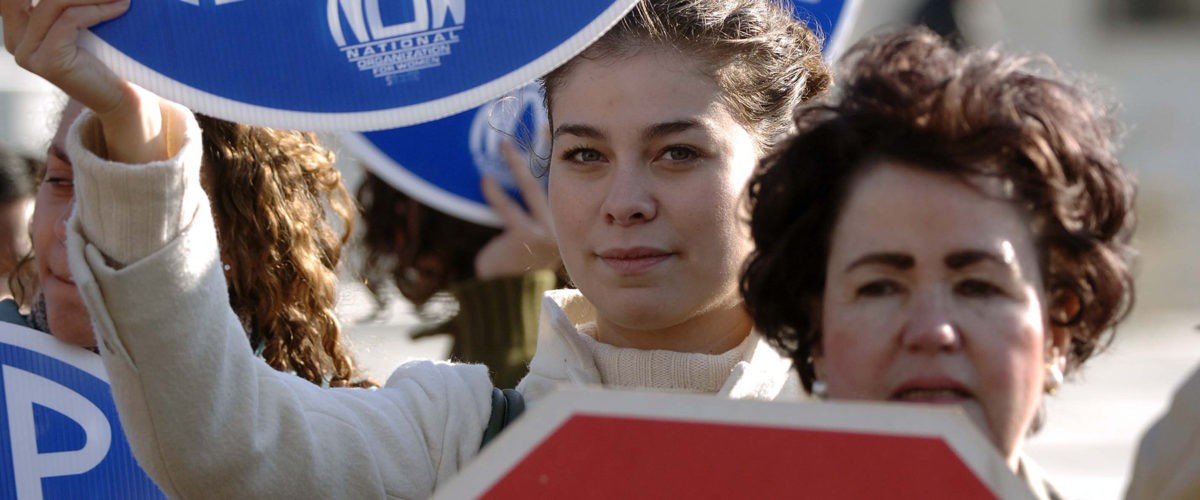If you listen to the most conservative and most liberal activists, you would think the 2020 presidential election is all about abortion rights. It turns out that is not exactly true, although abortion remains a highly motivating factor for certain segments of voters.
Fresh data from Gallup indicates that voters rank a dozen other issues as more important than abortion in determining their vote. Topping the list is an old favorite that got Bill Clinton elected in 1992: The economy.
In national polling conducted Sept. 14-28, nearly nine out of 10 registered voters listed the economy as the single most-important issue that could affect their vote for president. That includes 44% who ranked the economy as “extremely important” and 45% who ranked it as “important.”
In national polling conducted Sept. 14-28, nearly nine out of 10 registered voters listed the economy as the single most-important issue that could affect their vote for president.
Abortion came in 13th, with 61% of voters listing it as “extremely important” or “important” to their vote. Abortion ranked behind the economy, terrorism and national security (83%), education (82%), health care (80%), crime (79%), response to the coronavirus (77%), race relations (76%), foreign affairs (74%), gun policy (68%), immigration (65%), the federal budget deficit (65%), and relations with China (64%).
Abortion tied with taxes (61%) for importance and was rated more important overall than climate change (55%) and relations with Russia (49%).
In the nine months from December to September, the percentage of voters listing the economy as “extremely important” rose from 30% to 45%. Also, the percentage elevating race relations to be “extremely important” rose from 23% to 40%.
Election year priorities
For the economy to take center stage during an election year is nothing new, Gallup reported. “In each presidential election year since 1996, between 85% and 95% of registered voters have rated the economy as extremely or very important.”
What is different this year is the divide between left and right on ranking what is most important in choosing a president.
In 2016, partisans on the left and right generally agreed on the top issues, Gallup noted.
But this year, “Looking at the issues that are rated extremely or very important to vote choice by at least three-quarters of partisan voters, there are few similarities beyond both partisan groups viewing the economy and education as important to some degree,” Gallup said.
Democrats most commonly list their priorities as health care, the coronavirus response, race relations, climate change, the economy and education. Republicans most often cite the economy, national security, crime, education and gun policy.
“The largest gap between partisans is in how important they consider climate change — 88% of Democrats rate it as important compared with 23% of Republicans,” Gallup said. “Wide disparities are also seen in the importance of health care, the response to the coronavirus (32 points) and race relations (27 points). At the same time, Republicans place significantly more emphasis than Democrats do on several other key voting issues, including terrorism or national security (22 points) and taxes (18 points).”
The abortion gap
On abortion, the gap isn’t so wide. Gallup found an 8-point gap between Democrats (56%) and Republicans (64%) who cited abortion as “extremely important” or “important” to their vote choice.
Gallup found an 8-point gap between Democrats (56%) and Republicans (64%) who cited abortion as “extremely important” or “important” to their vote choice.
Earlier Gallup polling conducted in May 2020 found only 24% of Americans saying they will only vote for a candidate who shares their view on abortion. Although representing just one-fourth of voters, that attitude is on the rise compared to most recent years, Gallup said.
“Gallup has periodically tracked Americans’ views of the importance of abortion in their vote choice since 1996,” the polling firm reported. “Last year’s 29% reading for those who say a candidate must share their views on abortion to win their support was the highest on record. Before that, from 1996 to 2016, the annual average was 18%.”
Dig a layer deeper, however, and another stark difference emerges. Voters who consider themselves to be “pro-life” are more likely than those who consider themselves “pro-choice” to make abortion their sole determining factor in voting.
That gap has widened, Gallup said. Currently, 30% of those who identify as “pro-life” and 19% who identify as “pro-choice” say they are single-issue voters on abortion.
A result of minority rule?
The elevation of abortion to such prominent campaign status has been cited as evidence of minority rule. Simply put, the majority view of public officials elected at the federal level often doesn’t match national polling on the same issues. This is because of gerrymandered Congressional districts and the fact that smaller states get the same representation in the Senate as much larger states. It also has to do with the inequity of the Electoral College, which, for example, allowed Donald Trump to be named president four years ago despite losing the popular vote.
This minority rule effect often applies even on the state level, according to reporting by The Cut, which cites extremely restrictive abortion bans enacted in Alabama, Ohio, Georgia, Mississippi and Kentucky as examples.
“The notion that a fetus with a heartbeat is a person — and that the state should therefore treat aborting a pregnancy after six weeks as an act of murder — is an utterly fringe notion in American life,” reported Eric Levitz on the news site. “And this is true not merely at the federal level but also in every U.S. state. The progressive think tank Data for Progress recently applied national survey data on abortion … to conventional demographic-modeling methods in order to estimate state-level support for a variety of abortion policies. It found that there is not a single state in the union where a majority of voters support ‘making abortion illegal in all circumstances.’”
Gallup data backs up this finding, with a May 2020 poll showing eight in 10 Americans believe abortion should be legal to some degree, and a majority don’t want the landmark Supreme Court ruling Roe v. Wade overturned.
29% of Americans believe abortion should be legal “under any circumstances”; 20% say it should be illegal in “all circumstances.”
Gallup reported that currently, 29% of Americans believe abortion should be legal “under any circumstances,” 14% say it should be legal “under most circumstances” and 35% say it should be legal “only in a few circumstances.” On the other hand, 20% say it should be illegal in all circumstances.
“The combined 79% of Americans who think abortion should be legal in all or under certain circumstances echoes the majority public support Gallup consistently finds for upholding Roe v. Wade,” the firm added.
Asked a different way, however, Gallup data finds more nuance, with 70% of Americans either opposing abortion or favoring some limits on it. “Large majorities of Americans … have consistently said it should not be legal in the second (65%) and third (81%) trimesters.”
When asked to identify themselves as “pro-choice” or “pro-life,” the American public divides nearly evenly, Gallup reported, with 48% claiming the “pro-choice” label and 46% claiming the “pro-life” label.
Actual abortion rates falling
Meanwhile, as the debate rages on and a Supreme Court justice nominee waits in the wings who could tip the scales on the abortion issue, the actual number of abortions being performed in the United States continues to decline.
The two primary collectors of data on abortion rates are the Centers for Disease Control and the pro-abortion group the Guttmacher Institute. Each uses different methodologies and reports different numbers, but they both report the same downward trend.
According to the CDC, the number of reported abortions performed in America reached a peak in 1990, at 1,429,247. That represented 24 abortions per 1,000 women ages 15 to 44. Both the total number of abortions and the rate per 1,000 women of child-bearing age have continued to decline every year since then. The CDC reports that in 2016, it documented 623,471 abortions, which is 11.6 per 1,000 women ages 15 to 44 — less than half the number or ratio of 1990.
The Guttmacher Institute in a recent report highlighted a significant drop in abortions between 2011 and 2017.
“The number of abortions fell by 196,000 — a 19% decline from 1,058,000 abortions in 2011 to 862,000 abortions in 2017,” the institute said. “The abortion rate (the number of abortions per 1,000 women aged 15–44) fell by 20%, from 16.9 in 2011 to 13.5 in 2017.
The abortion ratio (the number of abortions per 100 pregnancies ending in either abortion or live birth) fell 13%, from 21.2 in 2011 to 18.4 in 2017.”
Does who’s in the White House matter?
There’s a meme going around on social media claiming that during Democratic presidential administrations, the abortion rate declines more than during Republican administrations.
The meme with accompanying chart says: “Neither party wants to see abortions increase. The difference is in strategy: the Republicans approach of ‘Make it illegal’ vs. the Democrats approach of ‘Make it unnecessary.’ Which is more effective? The numbers speak for themselves.”
The graph cites the CDC as its source to portray the rate of abortions declining marginally under Republican presidents and more dramatically under Democrats.
 According to the social media graphic, the abortion rate per 1,000 women ages 15-44 dropped 4% in the Reagan administration, another 4% in the George H. W. Bush’s administration, 30% during Bill Clinton’s two terms, slowed to only a 3% drop once during the George W. Bush administration, then shot down 26% during the Obama administration.
According to the social media graphic, the abortion rate per 1,000 women ages 15-44 dropped 4% in the Reagan administration, another 4% in the George H. W. Bush’s administration, 30% during Bill Clinton’s two terms, slowed to only a 3% drop once during the George W. Bush administration, then shot down 26% during the Obama administration.
The fact-checking website PolitiFact looked into this and reported those percentages appear to line up with actual CDC data but understanding that data requires missing context.
“In analyzing the post, we found two issues. First, states voluntarily report abortion data to the CDC, and which states report data varies wildly from year to year. For instance, California hasn’t reported abortion data in more than two decades. Second, experts say the post oversimplifies the reasoning behind the decline and overstates the role the occupant of the White House plays.”
PolitiFact labeled the social media meme “half true.”
The fact-checking project quoted Daniel Grossman, a professor of obstetrics, gynecology and reproductive sciences at the University of California, San Francisco, to explain more: “I think it is an oversimplification to say there is an association between the abortion rate and the political party occupying the White House. Many of the policies that might affect the abortion rate vary at the state level. These include things like whether there has been an expansion of programs, including Medicaid, to provide contraception for people living on low incomes, or alternatively, policies that might make it more difficult for clinicians to provide abortion care.”
There also are other factors possibly contributing to the drop in abortion rates, Elizabeth Nash, the Guttmacher Institute’s senior state policy manager, told PolitiFact.
“Between 2011 and 2017, the abortion decline appears to be driven by fewer people becoming pregnant in the first place, as both abortions and births declined.”
“Between 2011 and 2017, the abortion decline appears to be driven by fewer people becoming pregnant in the first place, as both abortions and births declined. If abortion restrictions were the main driver across the board, we’d expect the birth rate to increase,” she said. “There are a lot of potential factors at play, including increased access to affordable contraception (due to the Affordable Care Act among other policies that make it easier to afford contraception), new methods of contraception, and changing pregnancy desires and attitudes.”
The fact-checking website Snopes concurs with PolitiFact on this analysis, rating the social media graphic a mixture of true and false.
“What’s true: The abortion rate has steadily declined since the 1980s throughout both Democratic and Republican administrations, with a greater rate of decline during the former. What’s false: The reasons behind differing rates of decline in the abortion rate cannot be definitively tied to actions undertaken by the administrations of different political parties.”
The bottom line: For an issue on which so many express such definitive certainty, there’s a lot we still don’t know for sure. What is clear in this 2020 election cycle is that Americans hold within themselves conflicting opinions about abortion and government policies related to it — except for a small portion of the electorate for whom this is the only issue that matters.
 Mark Wingfield serves as executive director and publisher of Baptist News Global.
Mark Wingfield serves as executive director and publisher of Baptist News Global.
Related articles:
50 years later, abortion remains a political smokescreen
Can Christians come together to reduce the need for abortion?
Divisions over abortion and other life and death issues: the problem is not purple churches
As a pastor, I tried engaging the issue of abortion with Facebook friends. Here’s what I learned


